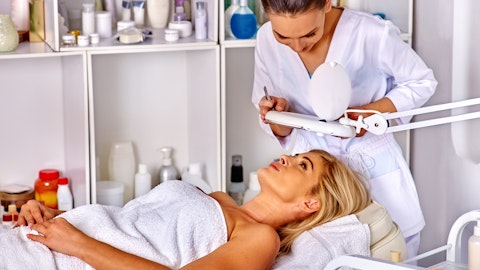Year-to-date, nearly, 45% of our net sales came from markets outside of the U.S. Moving on to net sales by product type. Our consumables business, which accounted for approximately 48% of our net sales in the quarter, saw a 17% year-over-year increase to $46.4 million. This further demonstrates our challenges are largely around delivery systems and more importantly, that the consumer continues to see high value in Hydrafacial treatments. On the system side, we saw a 4% year-over-year growth to $51 million, which was weighed down by performance in the U.S. Notably, delivery systems net sales in APAC and EMEA were plus 102% and plus 35%, respectively. During the quarter, we sold 2,140 systems at an average selling price of [$23.9000] down year-over-year, primarily due to an unfavorable mix shift towards distributor revenue.
Of the 2,140 systems, 362 were trade-ups. During the quarter, we reached a global installed base of 30,074 systems. We had a consolidated GAAP gross loss of $12.6 million, resulting in a GAAP gross margin of negative 12.9%. This was primarily driven by the Syndeo program charges of approximately $63.1 million. Additionally, this quarter, we incurred discrete charges of $6.4 million related to discontinued, excess and obsolete inventory. Normalizing for these charges, depreciation, amortization and stock-based compensation, adjusted gross profit was $60.9 million for a 62.5% adjusted gross margin. The adjusted gross margin was impacted by higher manufacturing labor costs and overhead, which we expect will subside as we continue to move portions of our manufacturing to China and sell through higher-priced inventory purchased in 2022.
Selling and marketing expense was $30.7 million or down approximately 23% year-over-year, primarily due to strategically pulling back marketing spend given the issues regarding Syndeo. The decline was further driven by lower compensation and sales commission expense, partially offset by a reversal of cash incentive accruals in the prior year. Going forward, while remaining disciplined, we plan to prioritize marketing initiatives to strengthen provider confidence and drive further awareness of our brand. Our data suggests Hydrafacial’s consumer brand has never been stronger, and our provider penetration is still low. R&D expense was $1.8 million for the quarter, relatively flat with historical trends. G&A expense was $37 million or plus 55% year-over-year, primarily driven by higher compensation, severance, share-based compensation and software expenses.
The reversal of cash incentive accruals in the prior year was also a driver. Altogether, this resulted in a net loss of $73.8 million. Normalizing for discrete charges, our adjusted EBITDA was $9.1 million, primarily due to gross margin pressures. This compares to a net loss of $0.1 million and adjusted EBITDA of $16.3 million when excluding any adjustments for discretionary cash incentives. Moving to the balance sheet. We ended the quarter with approximately $559 million of cash on hand. The cash balance reflects the repurchase of 0.8 million shares at an average price of $5.83 per share during the quarter. As of quarter end, we had approximately $95 million remaining in our existing share repurchase authorization. As of September 30, we had approximately 132.6 million shares outstanding.
We feel comfortable with our current liquidity position and together with our Board; we’ll continue to evaluate capital allocation, including liability management. Our inventory stood at approximately $74.9 million at the end of September, a decrease, compared to $109.7 million at December 31 last year, primarily as a result of the impairment charges taken during the third quarter. As of the end of the third quarter, we had approximately 1,300 trade-up elites in our inventory marked at fair market value. As we sell through these systems, there will be minimal gross profit given the trade-up accounting treatment and rules. We are estimating approximately 10% of this inventory will sell through in Q4 of 2023. Given the third quarter results, we are revising our previously stated fiscal 2023 guidance.



